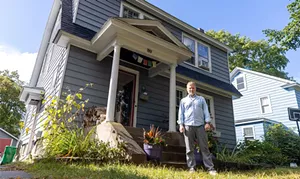
When architect Daniel Goltzman bought his home in the Five Sisters neighborhood of Burlington in 2013, he felt lucky. Just getting into the neighborhood was “a blood sport,” he recalled while standing in front of his 1931 home. The area’s small, unpretentious houses on quiet streets are within walking distance of downtown, Calahan Park and the Pine Street arts corridor. Plus, the house was well built. “I walked in and thought, Oh, this house has really good bones and a good floor plan,” said Goltzman, who owns Daniel Goltzman Design and Development. Later that year, he realized that his Caroline Street home might be a kit house. Popular in the first half of the 20th century, kit houses were ordered from catalogs and arrived in precut components stacked in a train boxcar. Hundreds of designs for them filled catalogs issued by a host of companies big and small, including Sears, Roebuck & Co.; Montgomery Ward & Co.; Aladdin; and Gordon-Van Tine. Goltzman was flipping through one such catalog on display at a modest house on the 2013 Preservation Burlington Homes Tour — he served on the nonprofit’s board at the time — when he spotted what looked like a dead ringer for his house: a Dutch Colonial with a gambrel roof sporting a large second-story dormer and, below, a small columned entry porch next to a triple window. The house across his street has an almost identical plan, as do more down the road. Kit houses seem to be everywhere in Burlington. That’s why Historic New England chose the city as the case study for its project “Kit Houses and 20th-Century Affordable Housing” and newly launched website, kithouses.org. The Haverhill, Mass.-based nonprofit owns and maintains 38 houses, farms and landscapes around New England, though none in Vermont. While many of the nonprofit’s properties are jaw-droppers — including the 1793 Lyman Estate in Waltham, Mass., and the 1938 Gropius House in Lincoln, Mass. — the kit houses project is part of the organization’s rather different initiative to document and preserve historic affordable housing. Charlotte Barrett, who developed the website, is the nonprofit’s community preservation manager for western New England and its Vermont staff person. A Burlington resident who recently explored historic Chittenden County markets in a project titled “More Than a Market,” Barrett took an interest in city neighborhoods that appear to have kit houses. These include the Five…
Historic New England Highlights Burlington's 20th-Century 'Kit Homes'

